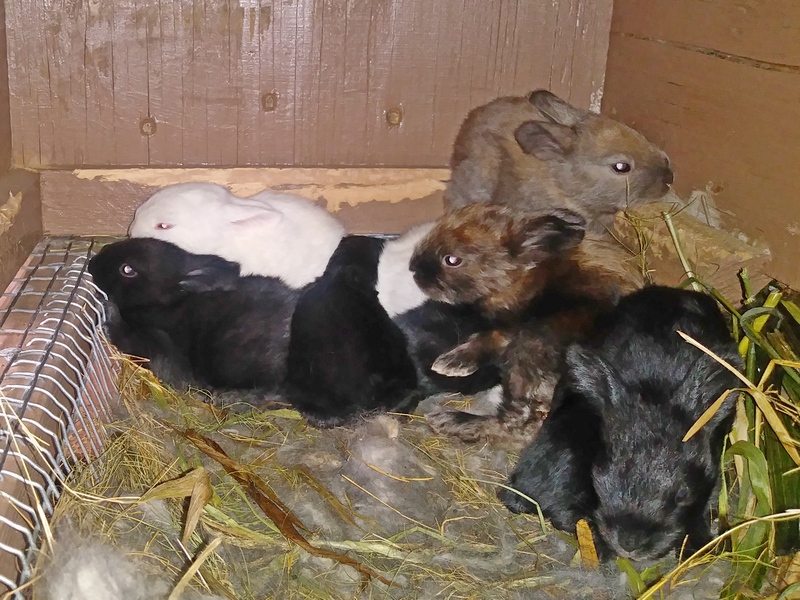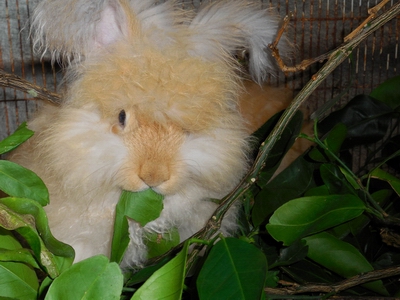Our hearts and best hopes go to everyone impacted by the Covid-19 virus.
Just because we're doing non-Covid things, doesn't mean we have forgotten the folks suffering from the virus.
We also really, really appreciate all those folks out there keeping things going and keeping everyone as healthy as possible.
It's still out there and getting fiercer! Be vigilant and continue to be safe!
Wear your mask!
Wash your hands!
yeah, I know, it sucks, but do it anyway
October 21st, 2020
Wear your mask!
Wash your hands!
yeah, I know, it sucks, but do it anyway
Summer Lunch with Mum Bun
Rose & Vladamir having lunch
Summer lunch with Mum
watermelon rinds are great bunny snacks
I guess the mainland is either already doing the fall season or at least thinking about it. It's kinda still summer here with corn and watermelons in the garden. Since the garden is right next to the sheep pasture, they're right there when the corn is being pulled up so they get most of the corn stalks. They are thrilled, they get excited with tasty stuff and wag their tails and bounce around. Bunnies aren't as excited about corn stalks as sheep seem to be. Bunnies love watermelon rinds and for some strange reason, the sheep won't eat them. The sheep don't like Romaine lettuce either. Weird sheep.
It's been kinda interesting mapping out the differences in sheep and bunny favorite foods. Bunnies are absolutely not supposed to eat avocados or avocado leaves, sheep aren't really supposed to either, but sheep seem to love avocados. One of our best bunny wranglers was walking through the sheep pasture with an avocado from under the big tree by the workshop. Cypress, the little ram sheep, pretty much mugged her to get the avocado. Then he got all excited about eating it, wagging his tail, licking his lips, dancing up and down. Extremely happy sheep, but I don't think they are actually supposed to eat avocados. However, even though they're not supposed to eat them, from this sort of behavior we can figure that they've somehow met and recognized avocados as something tasty from somewhere before. I don't think there were any avocado trees at Sunbonnet Farm and they're a higher elevation, not sure if avocados grow well there or not. But, Cypress definitely knew what avocados are and really got excited and really pushy to get one. There is an avocado tree up in the corner of their pasture over near the macadamia nut tree, perhaps they've dug through the grasses to get avocados there. I'll have to see how 'not supposed to eat' avocados are for sheep, if they're really bad for sheep we may have to take the tree down.
One of our rabbit wranglers has her own sheep; she said they adore bananas. So, on her expert advice, some bananas were offerred to Cypress and Flower, expecting happy sheep. Nope, they hadn't gotten the memo. They just turned their noses up at the idea of eating bananas and accepted handfed Guinea grass instead. The bunnies were very happy to eat the bananas and banana leaves the sheep didn't want.
Sheep seem to think Guinea grass that is hand fed to them is much better than Guinea grass that they have to pick themselves. Silly sheep. They have been doing a really good job of eating the tall grasses. Cypress has learned how to jump up on the grass and bend it over so they can reach the green leaves at the top of the grass stalks. They've cleared trails through the grasses all the way around their pasture. They've also blazed some trails through the middle so they can pop out of the center when they hear the lid of the metal can holding their sheep snacks.
The nutritional value of Guinea grass may not be enough for healthy sheep, so we give them their 'sheep snacks' which is a half can of alfalfa pellets mixed with either dry COB (Corn Oats Barley) or just rolled barley. They get a snack in the morning and evening. It also means the sheep are happy to see us and either come running or at least wander over fairly quickly when we are out either in or near their pasture.
This is also pretty much what the bunnies eat, although instead of just alfalfa pellets the bunnies get high protein bunny pellets but they can eat the 'sheep snacks' if necessary. What with the virus and less shipping these days, our local feed store doesn't always have everything in stock all the time. But, with the sheep able to eat bunny feed and bunnies able to eat sheep snacks, there's generally some sort of feed here for them. They can also eat grass, if we had no feed from the feed store, then we could do 'cut & carry' for all the bunny feed.
This little bun is a new herd buck, Hillside Vladamir. He's only five weeks old at the moment which is pretty early to be selected as a herd buck, but we really like him. Other than having excellent wool and lovely dense color, he's also the friendliest little guy. Rose and her litter are over in a bigger space now that they've outgrown the nesting hutch and Vladamir is the one up at the front asking for tasty things while everybunny else is kinda hanging back. He likes head scritches and will come running forward to get scritches and tasty things. Bunnies are a prey species, hanging back is actually what they should normally do, but we've been breeding for friendly and outgoing as well as bribing them for the same behaviors.
Black Rose had a litter of eleven, which is huge. She lost one early on and one later when they were being weaned. Getting nine babies weaned and off to a good start is a huge effort, Black Rose managed it without losing too much condition. She was stuffed with as much feed as possible and her nine are doing well. They're pretty much fully weaned at five weeks old now although they're still hanging out with mum bun for another month. Or at least, until they outgrow their larger space. With nine plus mum, that's ten buns and they're in the side hutch at the moment which is sized for about six buns. We will see how it goes in another couple of weeks, one of the big hutches may end up with a whole level cleared off for them. That will give them a ten foot by two and a half foot hutch space.
The size of the litter is one reason to keep a herd buck from this litter. Folks who raise bunnies for meat (don't mention it to the bunnies here, but rabbits are very tasty), anyway, folks who raise meat rabbits always select breed stock according to litter size. So, we can too, even though we don't eat them. As far as eating angora bunnies, the angoras grow slower than the ones raised for meat so by the time they're big enough to eat they aren't so tender anymore. Not that the bunnies here are complaining, they really like providing fiber by getting haircuts if one can go by how bouncy they get after a haircut.
Rose & Caesar's babies
approximately twelve days old
This is Vladamir at twelve weeks old. He's the darker brown one in the center. Even at twelve weeks old, he's got more vibrant color and longer wool. I'm not sure if the fuzzy ears are going to be extra fuzzy or not, though. That will be evident in a few more weeks, perhaps.
There is another matching 'extra fuzzy' & 'extra vibrant colored' bunny in that pileup, although she's somewhere on the bottom and not visible in the picture. I think that one is a doe, so she will be named Venus if she remains a she. It's pretty early to determine gender but they're acting like a buck and a doe, so I'm hoping the gender guess is spot on.
Should she be a she, when she's an adult she will be bred with DaffyDill who is the first of the 'extra fuzzies'. I'm trying to track the 'extra fuzzy' gene, I suspect it's a modifier to the long wool gene that angoras have. I'm not quite sure how to do that, though, not really being a geneticist. Any geneticists out there who know any way to track bunny fluffy coat genetics when there's only a few bunnies to work with, let me know.
The herd pages have been updated with our current bucks and does. Even Vladamir is listed on the bucks page, but Venus isn't on the doe page yet. Guess I should go fix that at some point. Hillside Bucks and Hillside Does. It's always a bit awkward to use 'doe' in the plural, maybe I should change the page names to 'Boy Bunnies' and 'Girl Bunnies', although then that sounds juvenile. Oh well, guess it can just stay that way.
I need to update the "Available Bunnies" page as well as the "In the Nestbox" page. With this many baby bunnies, there should be enough for everyone, although there's a waiting list so many of them already have new homes once they're big enough. But, I think there's still a few more than are being asked for, so if you want a bunny of your own - send us an email. Click on the 'Mail To' link below.
Mail to: Hillside Farm Hawaii
The male bunnies are usually $50 and the females are usually $75. They have a four generation pedigree and most of them are pure English angora. They are all pure angora, although some of them have a touch of Satin and/or German angora several generations back in their pedigrees.
If you're interested in setting up a breeding herd, ask about unrelated pairs. Due to the difficulty of getting good bloodstock in from the mainland, it will be great when we have more folks in Hawaii raising angora bunnies. If there's several herds, then we can occasionally swap bucks back and forth to keep down the levels of inbreeding and have healthier bunnies.
We can fly bunnies to Maui, Oahu, Molokai and Lanai. They can also go to Kauai, although that has some additional fees since there's a long layover on Oahu which needs a bunny sitter and a second airfare on Aloha Air Cargo to get them to Kauai. Email and ask for details.
Click on the picture above for the previous blog entry
or check the list of older blog posts at the bottom of this page
Click on the bunny for the Home Page




